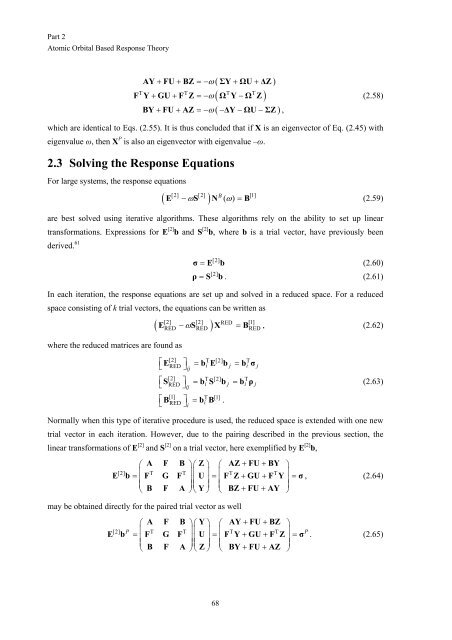Get my PhD Thesis
Get my PhD Thesis
Get my PhD Thesis
Create successful ePaper yourself
Turn your PDF publications into a flip-book with our unique Google optimized e-Paper software.
Part 2<br />
Atomic Orbital Based Response Theory<br />
AY + FU + BZ = − ω ( ΣY + ΩU + ∆Z )<br />
( )<br />
T T T T<br />
F Y+ GU+ F Z = −ω<br />
Ω Y −Ω Z<br />
BY + FU + AZ = −ω<br />
( −∆Y −ΩU −ΣZ<br />
),<br />
(2.58)<br />
which are identical to Eqs. (2.55). It is thus concluded that if X is an eigenvector of Eq. (2.45) with<br />
eigenvalue ω, then X P is also an eigenvector with eigenvalue –ω.<br />
2.3 Solving the Response Equations<br />
For large systems, the response equations<br />
( ω )<br />
[2] [2] [1]<br />
E − S N B ( ω ) = B (2.59)<br />
are best solved using iterative algorithms. These algorithms rely on the ability to set up linear<br />
transformations. Expressions for E [2] b and S [2] b, where b is a trial vector, have previously been<br />
derived. 61 [2]<br />
σ = E b (2.60)<br />
[2]<br />
ρ = S b. (2.61)<br />
In each iteration, the response equations are set up and solved in a reduced space. For a reduced<br />
space consisting of k trial vectors, the equations can be written as<br />
where the reduced matrices are found as<br />
( ω )<br />
[2] [2] RED [1]<br />
RED<br />
−<br />
RED<br />
=<br />
RED<br />
E S X B , (2.62)<br />
[2] T [2] T<br />
RED ⎦ i j i j<br />
ij<br />
⎡<br />
⎣<br />
E ⎤ = b E b = b σ<br />
[2] T [2] T<br />
RED ⎦ i j i j<br />
ij<br />
⎡<br />
⎣<br />
S ⎤ = b S b = b ρ<br />
[1] T [1]<br />
RED ⎦<br />
bi<br />
B .<br />
i<br />
⎡<br />
⎣<br />
B ⎤ =<br />
(2.63)<br />
Normally when this type of iterative procedure is used, the reduced space is extended with one new<br />
trial vector in each iteration. However, due to the pairing described in the previous section, the<br />
linear transformations of E [2] and S [2] on a trial vector, here exemplified by E [2] b,<br />
⎛ A F B ⎞⎛ Z⎞ ⎛ AZ+ FU+<br />
BY ⎞<br />
[2] ⎜ T T ⎟⎜ ⎟ ⎜ T T<br />
E b = F G F U = F Z+ GU+ F Y<br />
⎟<br />
= σ , (2.64)<br />
⎟⎜ ⎜ ⎟⎜ ⎟ ⎜<br />
+ +<br />
⎟<br />
⎝ B F A ⎠⎝Y⎠ ⎝ BZ FU AY ⎠<br />
may be obtained directly for the paired trial vector as well<br />
⎛ A F B ⎞⎛Y⎞ ⎛ AY+ FU+<br />
BZ ⎞<br />
[2] P ⎜ T T ⎟⎜ ⎟ ⎜ T T ⎟ P<br />
E b = F G F U = F Y+ GU+ F Z = σ . (2.65)<br />
⎟⎜ ⎜ ⎟⎜ ⎟ ⎜<br />
+ +<br />
⎟<br />
⎝ B F A ⎠⎝ Z⎠ ⎝ BY FU AZ ⎠<br />
68

















